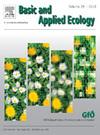水文动态、湿地形态和植被结构决定了人工湿地中的河岸节肢动物群落
IF 3.5
2区 环境科学与生态学
Q2 ECOLOGY
引用次数: 0
摘要
湿地水文动态通常直接或通过植被组成的变化来决定湿地内或湿地附近生物群落的组成。然而,还有很多未知因素,尤其是河岸节肢动物如何应对这种动态变化。在这项研究中,我们使用了高分辨率水文数据,以及瑞典西南部 41 个人工湿地中放牧牲畜的情况和海岸线植被高度,以探索洪水区面积、洪水频率、植被和放牧对常驻节肢动物群落的影响。采集的材料包括 26,817 只节肢动物,其中最主要的类群是双翅目(13,258 只标本)、蜘蛛(6,207 只)和鞘翅目(2,858 只),这些节肢动物是通过 SLAM(海陆空恶意)诱捕法、坑阱诱捕法和河岸节肢动物真空取样法采集的。我们发现,淹没频率会对特定类群产生影响,淹没频率较高的湿地中,某些甲虫和鞘翅目昆虫的数量较少,而低水位期较长的湿地中,毛翅目昆虫和异翅类昆虫的数量较少。与此相反,洪泛区面积的大小只影响到一些狼蛛类群,它们在洪泛区面积适中的湿地中数量较多。海岸线植被高度对蜘蛛、甲虫和双翅目等多个类群都有影响,但影响的方向不同,而放牧牲畜对丰度和群落组成的影响有限。鉴于对湿地水文和结构驱动因素的不同反应,湿地节肢动物群落似乎将受益于当地湿地生境的高度可变性,或各个湿地具有不同水文动态、形态和植被的湿地景观。本文章由计算机程序翻译,如有差异,请以英文原文为准。
Hydrological dynamics, wetland morphology and vegetation structure determine riparian arthropod communities in constructed wetlands
Wetland hydrological dynamics often dictate the composition of biological communities found in or near wetlands, either directly or through changes in vegetation composition. However, much remains unknown, particularly regarding how riparian arthropods respond to such dynamics. In this study, we used high-resolution hydrological data, along with presence of grazing livestock and shoreline vegetation height from 41 constructed wetlands in south-western Sweden to explore flood zone areas, flood frequencies, vegetation and grazing as drivers of the resident arthropod communities. The collected material consisted of 26,817 arthropods, where the dominant groups were Diptera (13,258 specimens), spiders (6,207) and Coleoptera (2,858), which were collected using SLAM (Sea Land and Air Malaise) trapping, along with pitfall trapping and vacuum sampling of riparian arthropods. We found group-specific responses to inundation frequencies, where wetlands with higher frequencies had lower abundances of some beetles and tipulids, and where wetlands with longer low-water table periods contained less trichopterans and heteropterans. In contrast, the size of flood zone areas only affected some wolf spider groups, that were more abundant in wetlands with intermediately sized flood zones. Shoreline vegetation height affected multiple groups, spiders, beetles and dipterans, but in different directions, whereas presence of grazing livestock had limited impact on abundances and community compositions. Given the variable responses to wetland hydrological and structural drivers, it seems that wetland arthropod communities would benefit from a high local wetland habitat variability, or wetlandscapes where individual wetlands have differing hydrological dynamics, morphology and vegetation.
求助全文
通过发布文献求助,成功后即可免费获取论文全文。
去求助
来源期刊

Basic and Applied Ecology
环境科学-生态学
CiteScore
6.90
自引率
5.30%
发文量
103
审稿时长
10.6 weeks
期刊介绍:
Basic and Applied Ecology provides a forum in which significant advances and ideas can be rapidly communicated to a wide audience. Basic and Applied Ecology publishes original contributions, perspectives and reviews from all areas of basic and applied ecology. Ecologists from all countries are invited to publish ecological research of international interest in its pages. There is no bias with regard to taxon or geographical area.
 求助内容:
求助内容: 应助结果提醒方式:
应助结果提醒方式:


